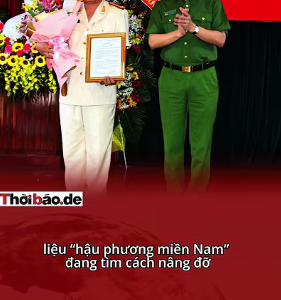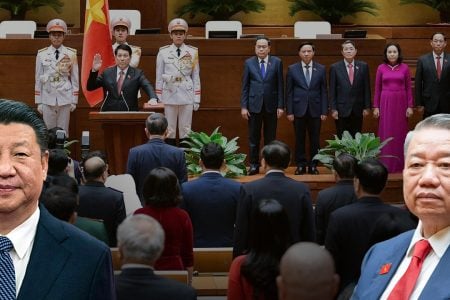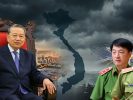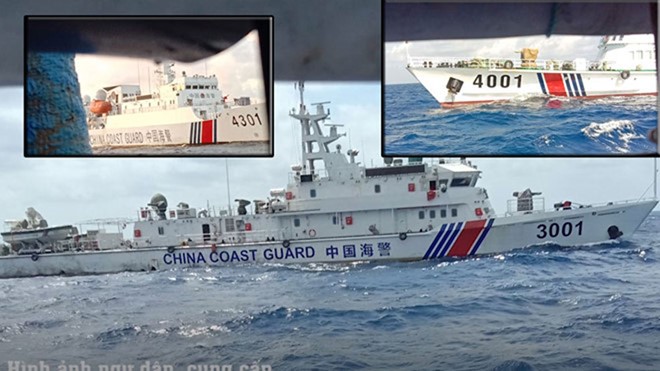
The US was „deeply concerned“ about reports of China’s sinking a Vietnamese fishing vessel near the Paracel Islands (the Hoang Sa) in the South China Sea (East Sea), US State Department spokesman Morgan Ortagus said in a statement on April 6.
On the evening of April 2, authorities in Quang Ngai told the press a fishing boat of local citizen Tran Hong Tho, was sunk by a Chinese boat near Phu Lam Island, in the Paracel Islands, where Vietnam claims sovereignty but in fact has been under Chinese control since 1974.
One day after the incident, on the evening of April 3, China returned eight Vietnamese fishermen who were crew members of the sunken fishing vessel.
US State Department Spokeswoman Morgan Ortagus called the collision the latest in a „series of actions“ by China to assert illegal maritime claims and disadvantage ”to neighboring Southeast Asia around the South China Sea.
In the April 6 statement, Ortagus listed a number of actions seen as China taking advantage of the global outbreak of the Covid-19 pandemic to assert illegal claims in the South China Sea, including Beijing’s „announcement of new research stations“ on military bases built on Cross Stone and Subi reefs, and landing „special military aircraft“ on Cross reef.
According to the US State Department spokeswoman, China has also continued to deploy maritime militia around the Spratly Islands.
Ortagus noted in the State Department’s statement that the nine-dashed line drawn by China on the South China Sea map was declared „an illegal maritime claim“ in the July 2016 ruling of the Arbitrary Court created under the 1982 Law of the Sea Convention, and this view was „shared“ by the US government, the spokeswoman said.
„We call on the PRC to remain focused on supporting international efforts to combat the global pandemic, and to stop exploiting the distraction or vulnerability of other states to expand its unlawful claims in the South China Sea,“ the State Department spokesman said.
Beijing responded to Hanoi’s request about the Chinese fishing vessel’s sinking of Quang Ngai fisherman’s ship by saying the Vietnamese fishing boat was coliding with the Chinese coast guard. This argument of Beijing was criticized by many and said that it was not much different from that of Hanoi authorities when a citizen suffered a broken nose bone due to „hitting“ on a traffic police stick.
Chinese Foreign Ministry spokesperson Hua Chunying said on April 4 that a Vietnamese fishing vessel took the initiative to crash the Beijing civil service ship in the South China Sea, causing the fishing boat to sink and Chinese law enforcement personnel rescued 8 fishermen.
„Early in the morning of April 2, a Chinese Coast Guard vessel, during a routine patrol, discovered a Vietnamese boat illegally fishing in inland waters off the Xisha Island of China (Hoang Sa – Vietnam) and immediately asked it to leave. Vietnamese ships refused and suddenly turned sharply towards Chinese ships.
Despite best efforts to keep the distance, the Coast Guard was rammed into the bow. Vietnamese fishing boats then entered the water and sank. The Chinese Coast Guard vessel immediately launched a rescue operation and all eight Vietnamese fishermen were rescued without any injuries.
„The China Coast Guard ship let fishermen go after completing the investigation procedures and collecting necessary evidence“ the Chinese official said.
“For a time, Vietnamese fishing vessels frequently invaded the territorial waters and inland waters off China’s Xisha Island (Hoang Sa – Vietnam) and violated Chinese fishing rights. They ignored and even took dangerous actions against Chinese law enforcement.”
“The Chinese side expressed deep concern and condemned the Vietnamese side about this issue and asked the Vietnamese side to seriously inform its fishermen and regulate their fishing activities to ensure they will not invade the related waters of China’s Xisha Island or make dangerous moves against Chinese law enforcement, „said Chunying.
Not long ago, Vietnamese Foreign Ministry Spokeswoman Le Thi Thu Hang said that with the sinking of a fisherman’s ship in Quang Ngai, China had infringed Vietnam’s sovereignty over the Hoang Sa, causing property damage, threaten the life safety and legitimate interests of Vietnamese fishermen.
On April 3, the representative of the Ministry of Foreign Affairs had a meeting with the representative of the Chinese Embassy and presented a protest note, asking the Chinese side to investigate, clarify and strictly handle Chinese civil servants and coast guard vessels mentioned above, not to repeat the same actions, and compensate adequately for the damage to Vietnamese fishermen.
According to information from the authorities of Vietnam, by April 3, 8 Vietnamese fishermen aboard the vessel QNg 90617 TS were safely received, „said Le Thi Thu Hang.
China has long claimed that the nine-dash line sovereignty covering 80% of the East Sea which was rejected by the Permanent Court of Arbitration in La Haye in 2016.
The Hoang Sa are administered by the Republic of Vietnam. On January 19, 1974, China opened fire to seize the archipelago, killing 74 South Vietnamese soldiers and controling these islands now.
On March 30, Vietnam’s Permanent Mission to the United Nations (UN) sent a note to the UN, responding to two notes issued by China on 12 December 2019 and March 23.
On March 23, China sent a note to the UN to respond to Philippine documents, saying that China „has sovereignty over the Nansha Islands and adjacent waters„, „has sovereignty and jurisdiction over the Philippines.“ related waters, with the seabed and the ground „. Beijing also claims that it has „historic rights“ in the East Sea, based on „historical and legal evidence.“
In a Malaysia document response note dated December 12, 2019, China said it had „sovereignty“ over the islands in the East Sea, „including the Spratly, Xisha, Zhongsha and Nansha Islands.“ China also mentioned „historical rights“ in the East Sea.
The Nansha and Xisha Islands are how China calls the Trương Sa (Spratlys) and the Hoang Sa (Paracels) of Vietnam.
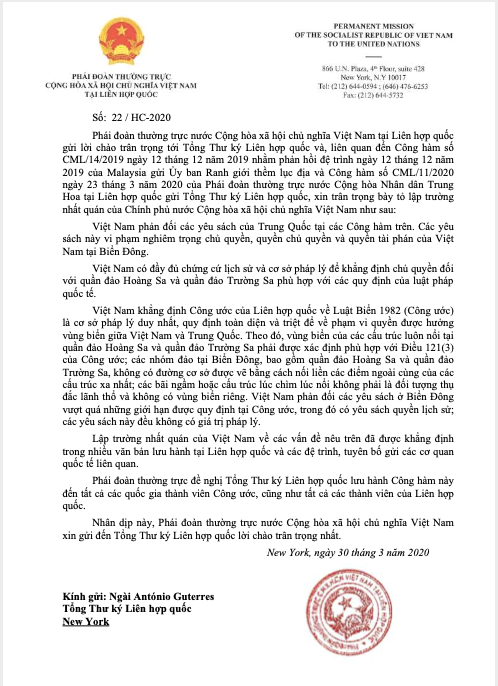
„Vietnam opposes China’s claims in the above notes. These claims seriously violate Vietnam’s sovereignty and jurisdiction in the East Sea,“ the March 30 note of Vietnam said.
The Vietnamese delegation at the United Nations reiterated that Vietnam has sufficient historical evidence and legal grounds to assert sovereignty over the Paracel and Spratly Islands, in accordance with the provisions of international law.
Vietnam considers that the UN Convention on the Law of the Sea 1982 (UNCLOS) is the only legal basis, comprehensive and comprehensive regulations on the scope of maritime entitlement between Vietnam and China.
„Vietnam opposes claims in the South China Sea beyond the limits prescribed in UNCLOS, including the historical right, these claims have no legal value,“ the Official Letter dated March 30 said.
According to the Vietnamese Delegation to the UN, Viet Nam’s consistent stance on the above issues has been affirmed in many circulating documents at the UN and submissions and declarations to relevant international agencies.
The Mission requested the Secretary-General of the United Nations to circulate Vietnam’s March 30 note to all UNCLOS member states, as well as all UN members.
Recently, on March 29, China again randomly sent military aircraft to the Truong Sa.
A satellite image of ImageSat International (ISI, Israel) on March 29 showed that Chinese Y-8 military transport aircraft landed illegally on Cross rocks in the Vietnamese Truong Sa.
Earlier on March 20, Xinhua news agency reported that China set up two research stations on the Cross and Xu Bi rocks, also in the Truong Sa.
These two facilities will monitor and measure changes in ecological ecology and environment in these sea areas. The two facilities are said to be in combination with an earlier Chinese research center built at Mischief Reef in the Truong Sa.
However, the international community cannot believe that Beijing makes claims about building facilities at the Cross or Xu Bi rocks for scientific research.
The move to build a research station on the Cross Rock and Xu Bi Rock is a familiar tactic from China. Beijing often takes advantage of times when the situation is complicated and countries with other concerns take action.
Vietnam is a country with nearly 100 million people close to China, throughout its thousands of years of history, this country has always suffered from invasions from its northern neighbor.
But the worst thing in the last century is that the revolutionaries in Vietnam made the wrong choice when they joined China and brought Communism to spread in the country, millions of the lives of both North and South were killed for this kind of painful doctrine. A comprehensive exit China-independent policy to return to the nation, is a wise choice now that the Communist Party of Vietnam needs to make.
Thu Thuy from Hochiminh city – Thoibao.de (Translated)



